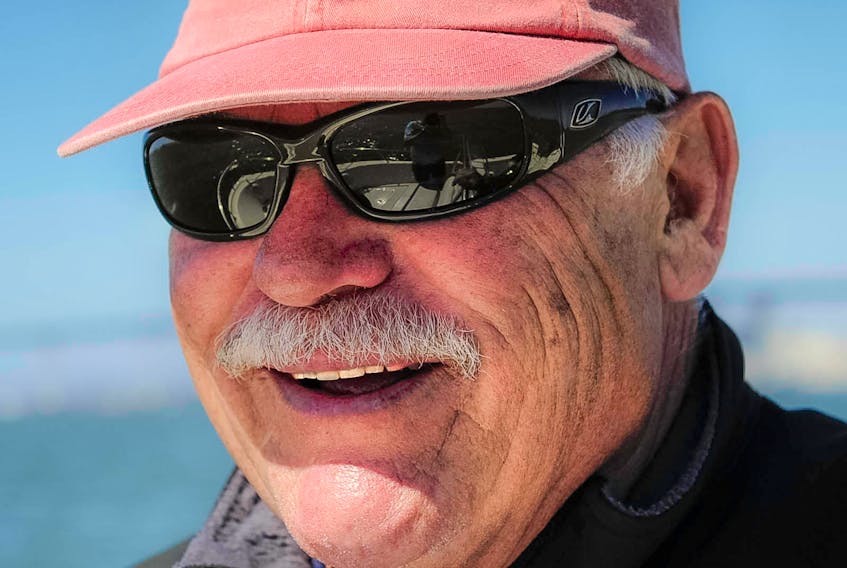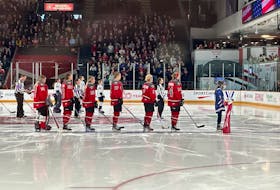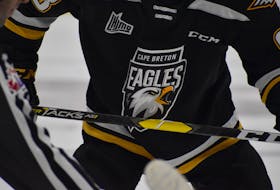Andreas Josenhans is well-acquainted with the history of the Bluenose.
The legendary sailor lives five kilometres from the town of Lunenburg and has enough credentials to fill the hold of the Bluenose, which at one time would have been stocked with fish after a successful catch off the Grand Bank.
The Canadian Sport Hall of Fame inductee is also a big fan of the famed vessel. He can seemingly quote chapter and verse from Keith McLaren’s book, ‘A Race For Real Sailors: The Bluenose and the International Fishermen’s Cup.’
His expertise comes from years on the water, winning world championships, competing for Canada at the Olympics and being a member of an America’s Cup championship crew.
When Josenhans dives in to discuss the magnificence of the Bluenose, he references a large photo that once adorned the United States departure area at Halifax’s Stanfield International Airport.
And then sitting just a little bit back with perfect sail trim, a lovely rolling bow wave, with every sail set as well as I know a sail should be set. There she is in full charge. It was an exemplary perfect start about to happen and all the other boats look quite shabby in comparison.
- Andreas Josenhans, describing a picture of the Bluenose
Josenhans sets the scene of the image that depicts a start to a race off Maugher Beach in Halifax by the lighthouse in a way only a great seaman could.
“You could see all the schooners and you could look at one and say the sail trim wasn’t very good. You look at another and say from where the starting line was and where it was, it wouldn’t get back in time. One is in a terrible position because another boat is in its air and then you see another one and say he’s going to be over early.
“And then sitting just a little bit back with perfect sail trim, a lovely rolling bow wave, with every sail set as well as I know a sail should be set. There she is in full charge. It was an exemplary perfect start about to happen and all the other boats look quite shabby in comparison.”
That boat, of course, was the legendary Bluenose, on the way to winning another race.
How it started
Friday, March 26 is the 100th anniversary of the famous racing and fishing vessel designed by Halifax’s William J. Roue.
The Bluenose was built for fishing and racing and went into service in April 1921. It was later that fall when the Bluenose would become known as a superior racing vessel.
Guided by captain Angus Walters, the Bluenose won a Canadian elimination race series to advance to the International Fishermen’s Cup. In the showdown for supremacy as the fastest fishing schooner in the North Atlantic deep-sea fishing industry, the Bluenose took down Elsie, the American challenger, in two-straight races. Walters, of Lunenburg, had captured the trophy and $4,000 prize money that was donated by the Halifax Herald Ltd.
In 1922, the Bluenose bested the Henry S. Ford in waters off Gloucester, Mass., to repeat as Cup champions.
The Bluenose became the boat to beat and companies began building vessels to take on that challenge.
“These different boats that competed against the Bluenose had relatively large corporations behind them and very successful track records as corporations and fishing companies,” said Josenhans. “This was a big dollar event at the time and Bluenose essentially came a little late to the party, but it came with very well-designed and very well equipped.
“The commercial fishery said by nature of the beast we race each other all the time. Not only do we race each other, but we race each other for monetary rewards. The first boat back from the Grand Banks has the greatest supply of fresh fish. The fresher the fish, the more money you get for it. There was a huge financial incentive to not only go catch fish but to bring them back first. When you think about the number of boats were talking about, the schooners and just the evolutionary development of these schooners. They became pretty darn good boats.”
And more challengers to take on Walters and the mighty boat.
Columbia, a newly constructed American boat, became the next competitor for the Fishermen’s Cup in 1923.
The Bluenose won a hotly contested first race with Columbia that featured the boats' riggings coming together. In the second race, the Bluenose was declared the loser on a rule infraction. Walters’ protest of the race was denied and he pulled the Bluenose from the competition. The Cup was declared a tie.
Josenhans said Walters didn’t "mess about when it came to the rules."
“If he felt the rules were being applied unevenly he would tend to get pretty gnarly. He would come to an event and would say that’s not quite what we agreed upon and he would take the boat, turn around and sail home. That’s serious stuff. It must have been pretty tough to deal with Angus. He did a pretty good job handling the show if you will. Nowadays there are ground rules upon how you run an event. Those didn’t exist then.”
Josenhans marvels at the sailing skills of Walters and skippers of that era.
“His seamanship, wow. He was the right skipper at the right time. Nowadays, you go out on the water and you know exactly where you are. You know exactly how fast you are going. You know all these things and you have all these sensors and all this incredible information.
“Well they didn’t have any of that and their compasses were not as good as they are today. Their measure of speed, when you put that into context today when they go out on the water, they would be horrified with how little information these schooner men had.”
Josenhans noted that a winning boat also needs a great crew.
“A big boat like that with a crew, it’s not only the skipper making great decisions or a skipper making reasonable decisions. It’s the crews' input to the skipper. Like ‘hey do you see this and what about this.’ There would have been an extreme loyalty for him to have the input of what would be needed to be that good.
“When he (Walters) said we have to take that sail down that’s beating itself to death up on that rig. They go up there and they have to beat that sail into submission, two or three people clinging with one hand to the ship and one hand for the job. When you’re, say 190 feet away from the skipper down at the steering wheel bellowing at you, there’s a pretty good amount of loyalty to take another step farther on the end of that.
“He had the ability to inspire his crew so when it comes to a boat that size that’s probably paramount to success.”
When asked if he had dreamed of being a crew member on the Bluenose, Josenhans, 70, said, ‘How could you not want to. How interesting would that be?
“Would I have wanted to go to the school of hard knocks to be a fishing boat captain, probably not? I don’t know if I’m tough enough for that because it wasn’t an easy life. Put me on the deck of a boat like that and have me race the thing is another question. That would be a whole heap of fun.”
The legend lives on
The Bluenose would win its last International Fishermen’s Cup in 1938. Four years later, the vessel was sold to the West Indies Trading Company. In 1946, the Bluenose hit a coral reef off Haiti and its wreck was abandoned.
The image of the Bluenose has been featured on postage stamps and is on the Canadian dime. The Bluenose and Walters were inducted into the Canadian Sports Hall of Fame in 1955.
Josenhans believes the Bluenose is still relevant today, ‘because it’s a bit of a story of hard knocks and the evolutionary development of a sailing ship.
“The determination to win and those kinds of episodes in our history appeal to us. This is what we’re going to do to get it done and to achieve that.
"She was fundamentally a better boat than what the U.S. was able to throw at us. It wasn’t that the U.S. was shy of resources. Why was ours better than everyone else for a long time? That is the appeal. Why did we become better? I don’t know but we did.”

Bluenose II sighting
Josenhans had an adventure with the reconstructed Bluenose II last year off Lunenburg and said it’s still a thrill to be on the water with the legendary boat.
“We were motoring around off Lunenburg and it was thick fog, hard to see maybe 100 feet. Then the fog lifted for an instant and we saw the Bluenose coming out about three or four miles away so we took a bearing on it and motored in her direction and surprisingly found her. There she was. We were in a powerboat with four people and here is this boat 160 feet long with a cloud of sail, in the fog, out of the fog, pushing a big bow wave. Everything on board was neat, tidy and organized. It’s an impressive sight. It’s inspiring and she is quick.”









